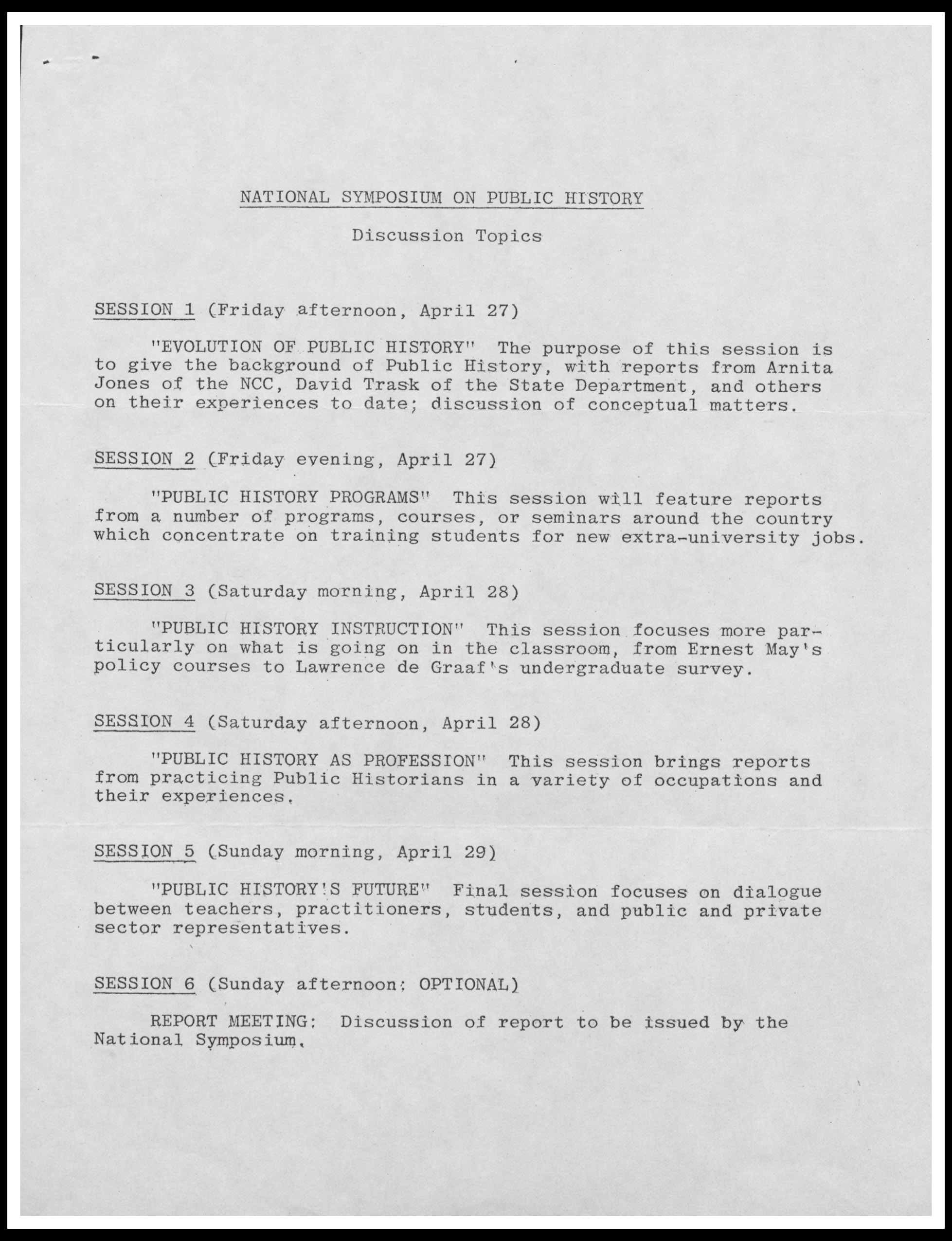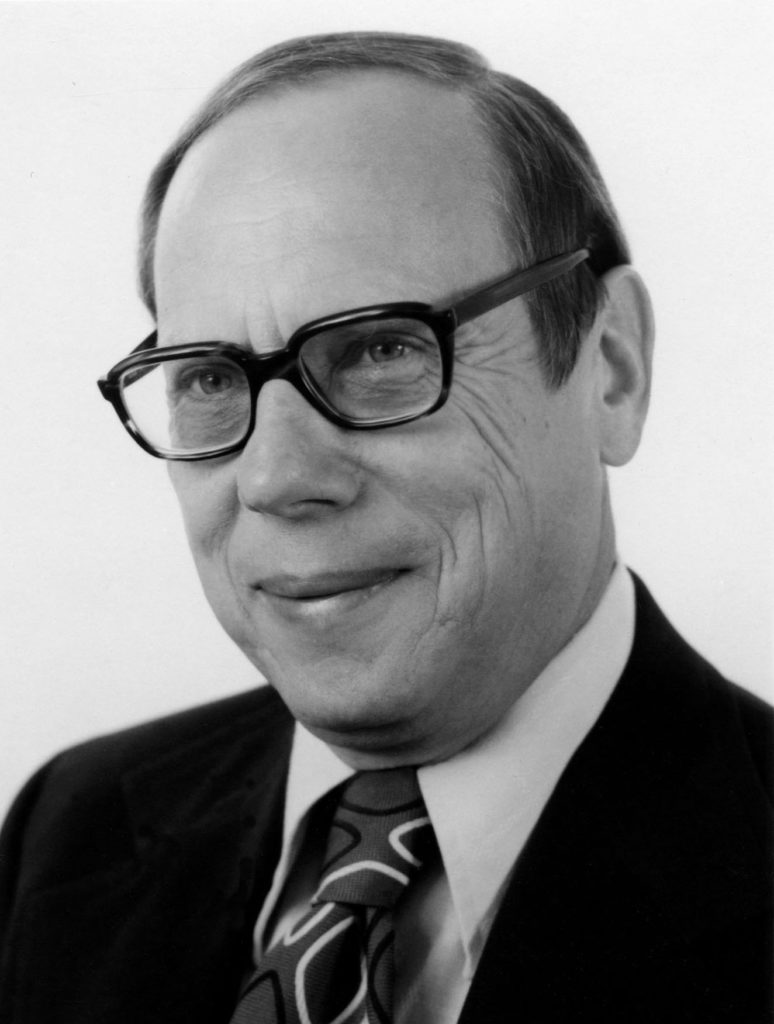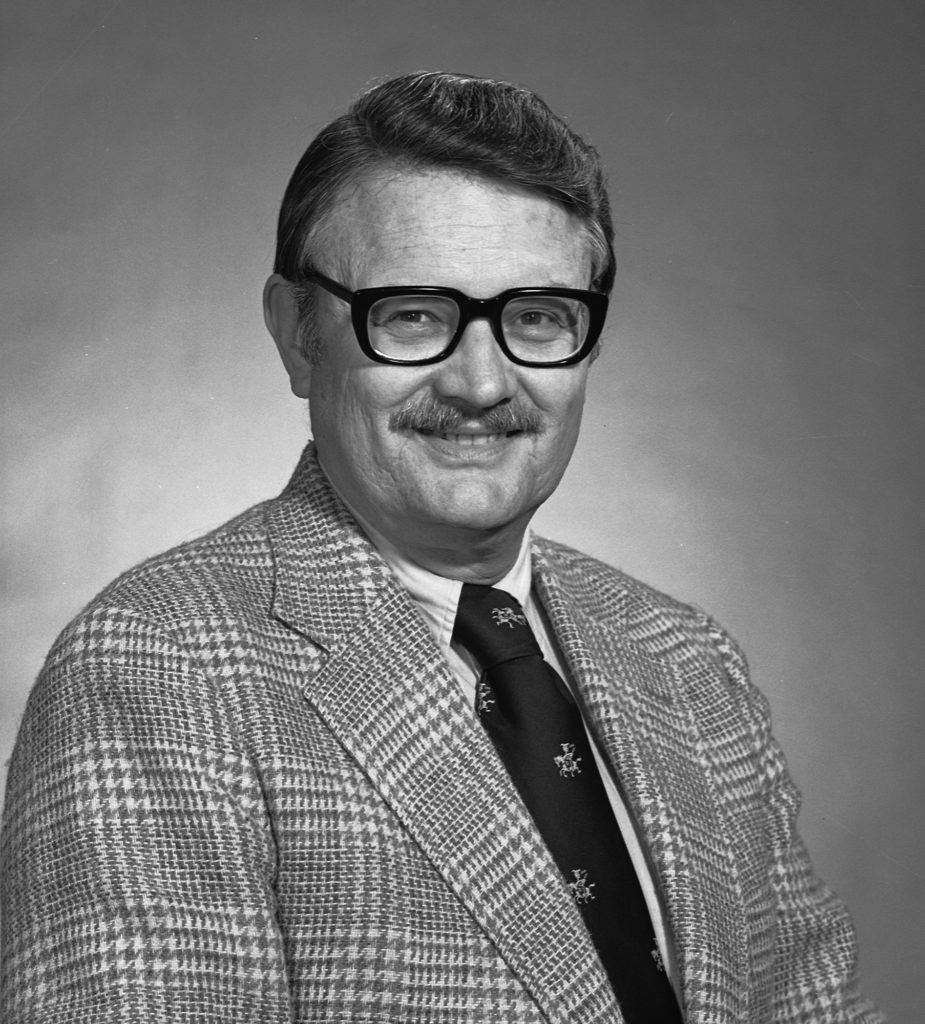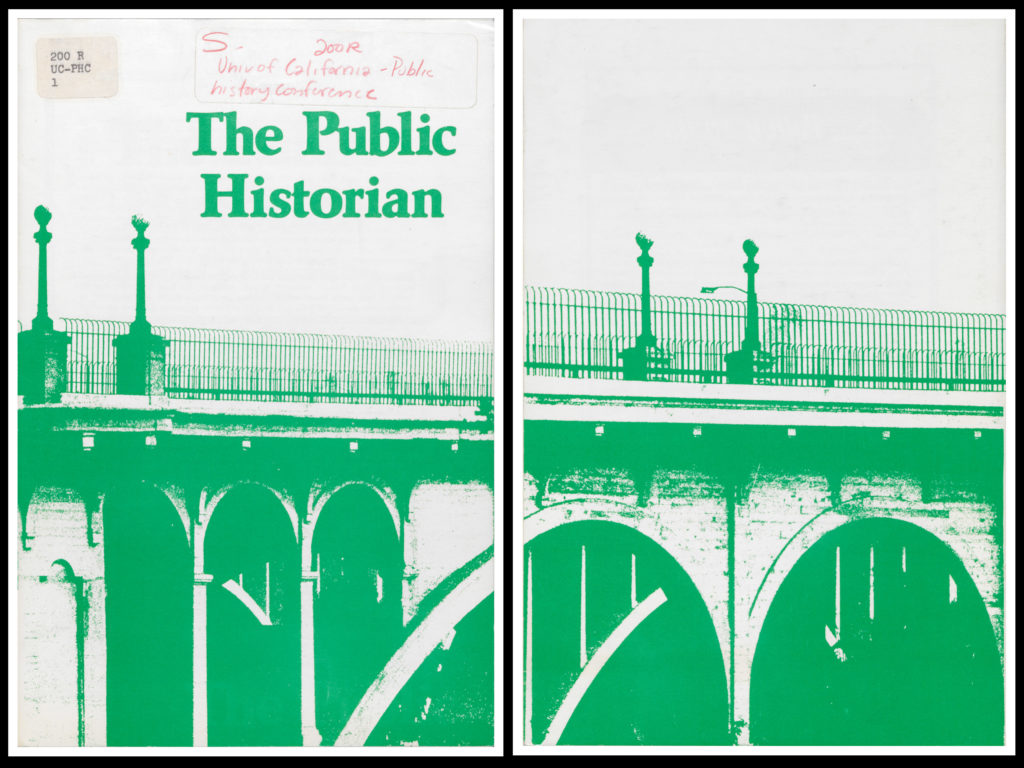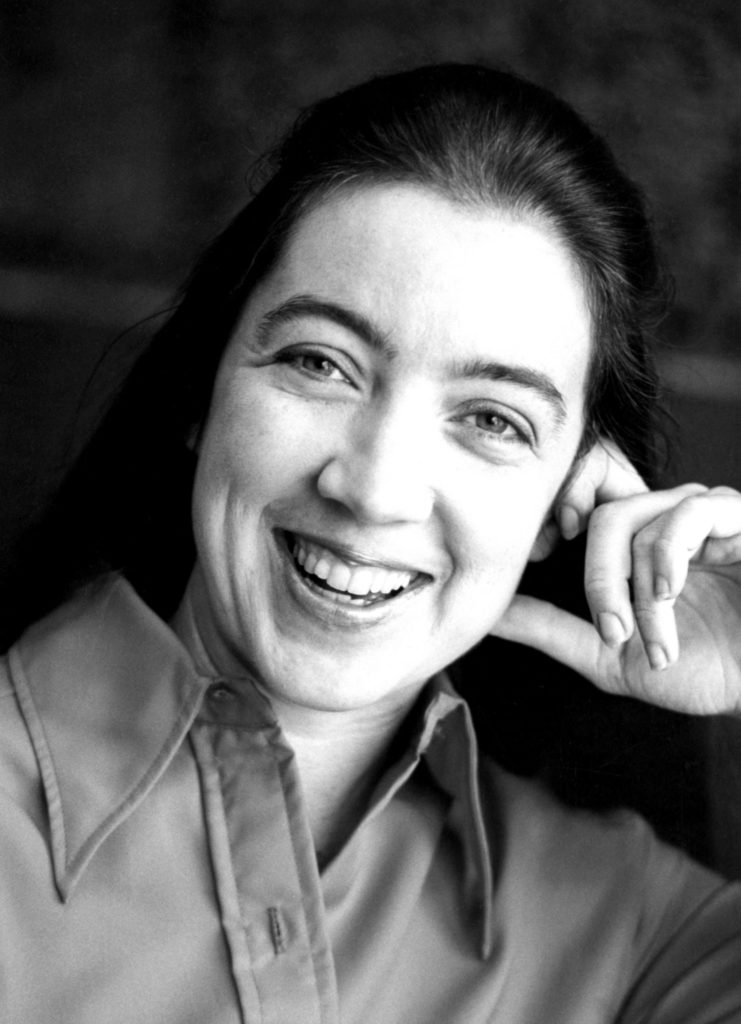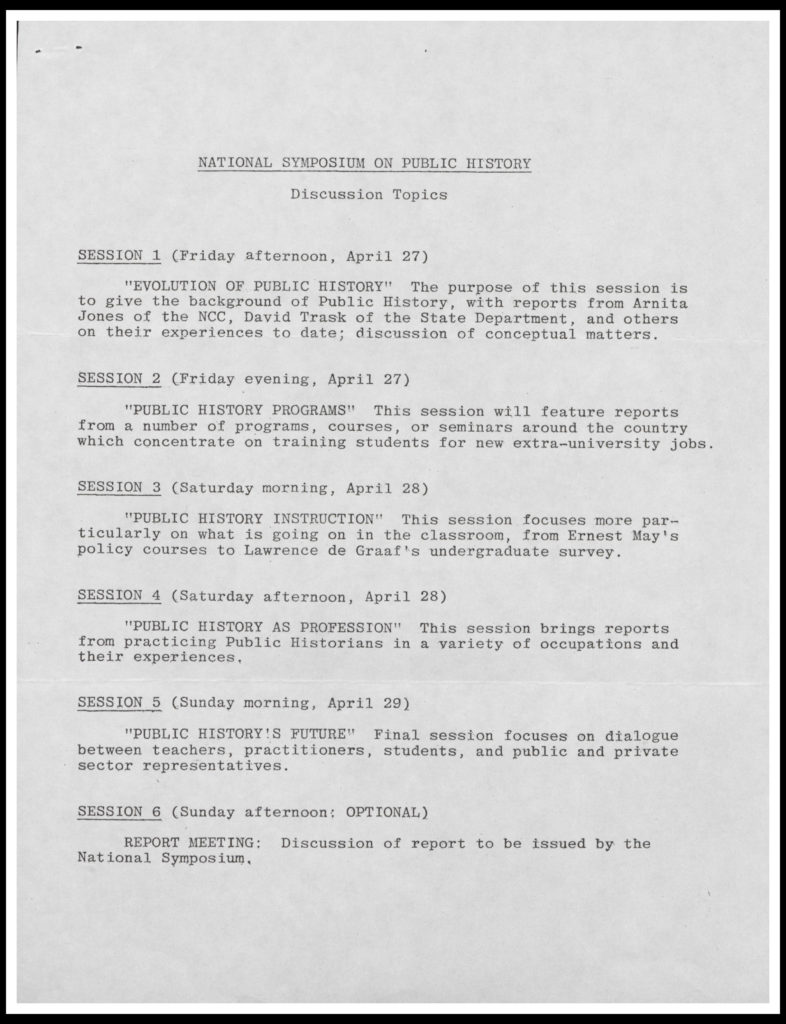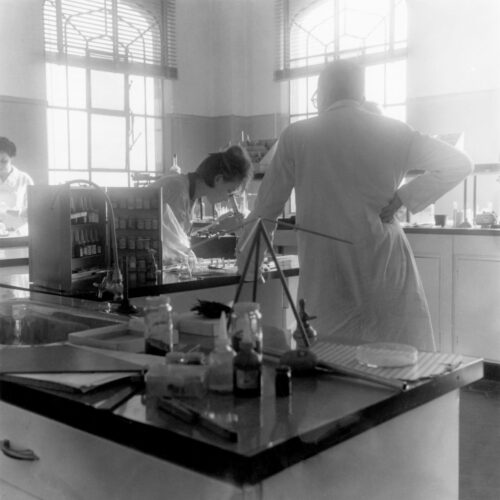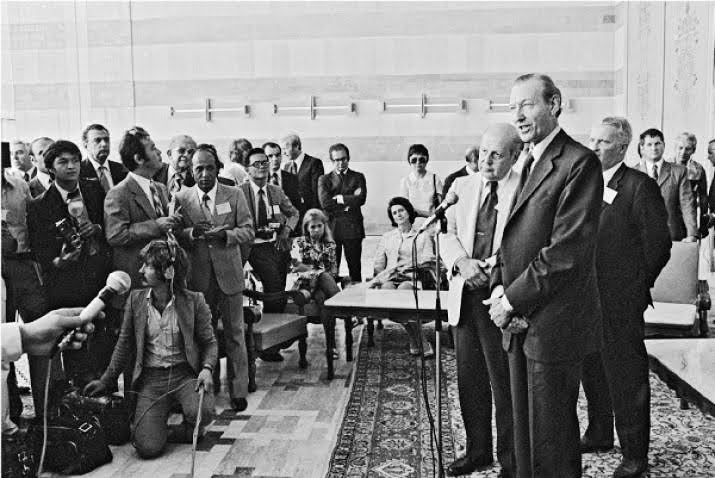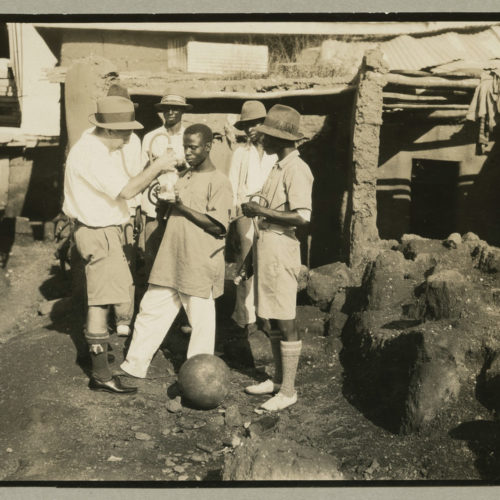Forty years ago, on May 2, 1980, the National Council on Public History (NCPH) came into official existence when it filed articles of incorporation in Washington, D.C. Leading public historians created this new professional organization to expand and explore what was then a new field. The development of the field itself, in the years before NCPH’s founding, owed an enormous amount to a close partnership between the Rockefeller Foundation (RF) and historians at the University of California at Santa Barbara. “Our History,” National Council on Public History, Accessed January 2, 2020.
What IS Public History?
On one level, public history is simply history that is consumed by the public outside of the classroom. But on another level, it can be seen as a distinct profession within the field of history. The University of California at Santa Barbara’s (UCSB) History Department today defines public history as a profession “to train historians for public and private sector careers beyond conventional academic employment.” Similarly, the NCPH defines the field as history at work, or history “applied to real-world issues.”“Public History,” UCSB Department of History- Fields of Study, UCSB, Accessed January 2, 2020.
New Uses for History
Why was a new distinction necessary by the 1970s? Historians had worked in non-academic settings for decades before the formalization of the public history field. Yet the creation of the NCPH, along with the development of the field across many sites and institutions, allowed government bodies, local historians, archivists, historic preservationists, museum professionals, historical consultants, documentarians, and others to collaborate. Furthermore, it empowered them to engage with societal issues under an umbrella with a clear concept and shared understanding.
Naming the field helped establish professional and intellectual identity. At the time, a job shortage loomed over newly minted academic historians. It worsened each year as more PhD degrees were awarded than new university posts were available. Therefore, historians sought to mobilize their academic training in new ways.“About the Field,” National Council on Public History, Accessed January 2, 2020.
A Potential Partner
At its founding in 1913, the RF had not concerned itself with the humanities; in fact, it focused as tightly as it could on professionalizing medical education and fostering what was at that time also a new field — public health. But as the twentieth century went on, the RF expanded its endeavors, and developed a growing interest in the humanities. It first established a Humanities Division in 1928.
A few decades later, in 1963, academic divisions such as “humanities” and “social sciences” were abandoned at the RF in favor of organizing work into multi-disciplinary, thematic areas, for example “Toward the Conquest of Hunger” or “Aiding Our Cultural Development.” The RF hoped that such a multi-disciplinary approach might bring more relevance to its work on the complex social issues of the 1960s.Joel Colton and Malcolm Richardson, “The Humanities and the Well-Being of Mankind: A Half-Century of the Humanities at the Rockefeller Foundation” 1982, Series 911, RG 3.2, Rockefeller Foundation records, Rockefeller Archive Center.
Return to the Humanities
In 1974, after a more-than-ten-year hiatus, the Foundation re-established a distinct Humanities Division with a renewed commitment to what it called a “fundamental objective”… “to associate the humanities with deep human concerns and to help illuminate the values of contemporary society.” The RF’s public humanities initiative aimed to reach new audiences and encourage new avenues of creativity. The Foundation thus awarded grants that would explore “neglected audiences by better integrating the humanities into education and daily living.”“Humanities at the Rockefeller Foundation in 1977,” revised report and cover letter from Joel Colton to VP’s, Directors, and AHCV Committee, June 23, 1977, Series 911, RG 3.2, Rockefeller Foundation records, Rockefeller Archive Center; The Rockefeller Foundation, Annual Report 1976 (New York: The Rockefeller Foundation, 1976), 70, 75.
Dr. Joel Colton, Director of Humanities at the RF, understood the importance of the public history movement. Colton argued that academics and other humanists should “emerge from their research retreats, share with us their information and ideas, and work with all of us to bring a more critical intelligence to bear on the cultural dilemmas of our day.”“Testimony, Dr. Joel Colton, Director of Humanities, The Rockefeller Foundation, December 16, 1977, New York, New York, Hearings in House Joint Resolution 639, a bill calling for a White House Conference on the Humanities,” Series 911, RG 3.2, Rockefeller Foundation records, Rockefeller Archive Center.
Surveying the Scene
Colton’s colleague, Dr. D. Lydia Bronte, Associate Director of Humanities at the RF, traveled throughout the US in 1973-1974 to survey humanities centers, and concluded that innovative ideas and programs were sorely needed.D. Lydia Bronte, ed., The Rockefeller Foundation Working Papers: A Guide to Humanities Centers in the United States (New York: The Rockefeller Foundation, January 1980), 1-8, 235-260. She witnessed the isolated nature of most of these centers and took special care to document any non-traditional centers she could find offering engaging public programming.Ibid., 3-4, 219-224, 238-246, 255-260.
At the same time, the Foundation also made grants to several traditional professional organizations, for example the American Historical Association, to explore alternative employment opportunities that might offset the job shortage among academic historians.Colton and Richardson, “The Humanities.”
Innovation in California
In 1976, the RF made a $107,000 grant for three years to a new graduate program in Public Historical Studies at the University of California at Santa Barbara (UCSB). Dr. Robert L. Kelley, UCSB history professor, launched this “highly innovative program in public history” inspired by his experience as an expert witness in a legal battle over utilities and property in the state of California.The Rockefeller Foundation Annual Report 1976 (New York: The Rockefeller Foundation, 1976), 76; Dr. Joel Colton to Esther S. Stamm, April 20, 1978, Folder “University of California-Public History Conference 1976, 1978-79,” Series 200R, RG 1.9, Rockefeller Foundation records, Rockefeller Archive Center; Joel Colton and Malcolm Richardson, “The Humanities.“Kelley spoke with the RF’s Colton, who agreed that Kelley’s new program had potential, arguing that
the need for expert, in-depth, historical research for similar problems… suggested ways in which the traditional training of graduate students might be broadened to enhance their qualifications to serve in federal, state, and municipal agencies and in private corporations.Colton and Richardson, “The Humanities”; Phone call Robert Kelley to Joel Colton, September 16, 1976, Folder “Officer: Colton, Joel,“RG 12, A-E, Rockefeller Foundation records, Rockefeller Archive Center.
Dr. G. Wesley Johnson, Jr., UCSB graduate public history program’s Director of Studies, picked up where Kelley left off, expanding the program by utilizing the RF’s “generous fellowship and program grant… to attract a national student body.” Bronte became the program officer responsible for the RF relationship with the UCSB program, and she and Johnson began a journey that would prove to have lasting impact.G. Wesley Johnson, Jr., “The Origins of the Public Historian and the National Council on Public History,” The Public Historian 21, No. 3, (Summer 1999): 168, 171, accessed January 2, 2020.
Publishing the Public Point of View
Bronte and Johnson had a successful and influential partnership throughout the late 1970s. Bronte assisted Johnson in his bid to launch a professional journal, The Public Historian, “dedicated to the proposition that historians are professional people, who possess certain marketable skills, which can be practiced in the governmental, business, education or general research areas.”G. Wesley Johnson, “Editor’s Preface,” The Public Historian 1, No. 1, (Fall 1978): 8-9; Phillip V. Scarpino, “Interview with Wes Johnson, Part I: April 17, 2015,” NCPH History @ Work (blog), March 14, 2019.
Today, that journal remains the flagship journal in the field. The UCSB public history program published six consecutive issues of The Public Historian, from the inaugural issue in Fall 1978 through Winter 1980, with funds supplied by the RF grant. The first issue included a letter to the editor in which Bronte expressed enthusiasm for the growing field’s “awareness that historical research can be taught and performed as an instrument to illuminate the public or organizational policy creat[ing] a new link between reflection and application.”
By the time its fourth issue was released (Summer 1979), the journal had hundreds of subscribers. With its Winter 1981 issue, it joined the roster of publications at the University of California Press. G. Wesley Johnson, “Front Matter,” The Public Historian 1, No. 1, (Fall 1978): 1; D. Lydia Bronte, “Letters to the Editor,” The Public Historian 1, No. 1, (Fall 1978): 14- 15; G. Wesley Johnson, “Front Matter,” The Public Historian 1, No. 4, (Summer 1979): 1, Accessed January 2, 2020; Thomas Fuller, “Editor’s Preface,” The Public Historian 1, No. 4, (Summer 1979): 1, Accessed January 2, 2020.
Bringing Practitioners Together
Bronte and Johnson’s collaboration fueled the progress of the public history movement. From 1978 to 1979, the RF assisted with the first national conference on public history and laid the groundwork for the creation of NCPH in 1980. Johnson later reflected that Bronte’s suggestion of a national conference had been instrumental to his decision to submit a proposal to the RF.G. Wesley Johnson, “The Origins of the Public Historian and the National Council on Public History,” The Public Historian 21, No. 3, (Summer 1999): 171-172, Accessed January 2, 2020; G. Wesley Johnson, “Editor’s Preface,” The Public Historian 1, No. 4, (Summer 1979): 6-7, Accessed January 2, 2020; G. Wesley Johnson, “Editor’s Preface,” The Public Historian 2, No. 1, (Fall 1979): 3, Accessed January 2, 2020.
Bronte, with her experience with humanities centers, their practitioners, and humanities-based conferences, provided essential guidance as Johnson developed the proposal from February to May 1978.Bronte, The Rockefeller Foundation Working Papers, 1-8, 235-260; Dr. G. Wesley Johnson to Dr. D. Lydia Bronte, January 30, 1978; Dr. G. Wesley Johnson to Dr. D. Lydia Bronte, February 24, 1978; Mr. B.G. Davis to Dr. D. Lydia Bronte, March 8, 1978; Dr. Joel Colton to Dr. G. Wesley Johnson, May 9, 1978; Dr. G. Wesley Johnson to Dr. Joel Colton, May 23, 1978; Folder “University of California-Public History Conference 1976, 1978-1979,” Box R2068, Series 200R, RG 1.9, Rockefeller Foundation records, Rockefeller Archive Center. Colton suggested a separate grant application for the conference, apart from broader public history funding. He then brought that to the RF Board of Trustees, praising the conference’s potential for developing the field of public history.Dr. Joel Colton to Esther S. Stamm, April 20, 1978; Dr. Joel Colton to Dr. Sterling Wortman, May 11, 1978; Folder “University of California–Public History Conference 1976, 1978-1979,” Series 200R, RG 1.9, Rockefeller Foundation records, Rockefeller Archive Center. Through June to July 1978, UCSB’s Public Historical Studies Program received an $18,000 grant for the conference, formally announced in the Rockefeller Foundation Annual Reports of 1978. The Rockefeller Foundation, Annual Report 1978 (New York: The Rockefeller Foundation, 1978) 88.
Preparing to Act As a New Field
Upon receiving notification of the grant in June 1978, Johnson wrote to Bronte and Colton, expressing his gratitude and inviting them to the conference scheduled for April 1979. Colton replied to Johnson with a list of potential speakers and offered additional assistance. Johnson officially announced the conference to the public history community in March 1979.Dr. G. Wesley Johnson to Dr. Joel Colton, June 23, 1978; Dr. G. Wesley Johnson to Dr. D. Lydia Bronte, June 23, 1978; Dr. Joel Colton to Dr. Wesley Johnson, June 29, 1978; Dr. G. Wesley Johnson, “National Symposium on Public History,” March 16, 1979; Folder “University of California–Public History Conference 1976, 1978-1979,”Series 200R, RG 1.9, Rockefeller Foundation records, Rockefeller Archive Center.
During the intervening time period between the June 1978 grant award and the conference announcement in March 1979, Bronte and Johnson held another influential discussion about the advancement of the public history movement. On October 30, 1978, they met in Bronte’s office at the RF. Johnson opened by hand-delivering to Bronte the first issue of The Public Historian, expressing his hope that the journal would “become a major vehicle for exchange on the public uses of history for an audience of both scholars and the public.”
When discussion then turned to planning the national conference in April, Johnson produced forty-eight replies to his survey of current public history programs in the US and raised the idea of forming an association among them. “Office visit memo 10-30-78,” Folder “University of California–Public History Conference 1976, 1978-1979,” Series 200R, RG 1.9, Rockefeller Foundation records, Rockefeller Archive Center.
Launching a New Network
In April, after the first National Symposium on Public History, Bronte declared the meeting “a very solid success.” Dr. Larry Tise, Director of North Carolina’s Division of Archives, commented that, while aspects of the field had existed for years, “little or no attention has been given to training historians to use their skills for the community at large.” He ventured that the conference seemed to have launched “a new period in the history of public history.”Dr. D. Lydia Bronte, “Trip Diary, Pubic History Conference, Santa Barbara, California, April 27-29, 1979,” Folder “Officer: Bronte, D. Lydia 1979-1980,” Box 47, RG 12, A-E, Rockefeller Foundation records, Rockefeller Archive Center.
Bridging a Gap
Bronte, thinking over the problems facing the humanities, ventured that programs such as UCSB’s might bridge the gap between “the academic island and the mainland strong enough to support continuing commerce between the two for many years…to the benefit of society.” The last session of the symposium generated the suggestion of establishing a steering committee to explore a national professional organization. G. Wesley Johnson, “The First National Symposium on Public History: A Report,” The Public Historian 2, No. 1, (Fall 1979): 7-9,69-70, 72, 83, Accessed January 2, 2020.
Within six months, on September 14, 1979, the steering committee voted to create the National Council on Public History in Washington D.C. The committee formally chartered NCPH at a second annual conference in Pittsburgh, PA on April 18-20, 1980. The members voted to transform themselves into a board of directors in same month.
NCPH filed for incorporation on May 2, 1980 and established the groundwork for the non-profit membership organization it has become today.G. Wesley Johnson, “Editor’s Preface,” The Public Historian 1, No. 4, (Summer 1979): 7-10, Accessed January, 2, 2020; G. Wesley Johnson, “Editor’s Preface,” The Public Historian 2, No. 1, (Fall 1979): 4, Accessed January 2, 2020; G. Wesley Johnson, “The Origins of the Public Historian”; Barbara J. Howe, “Reflections on an Idea: NCPH’s First Decade,” The Public Historian 11, No. 3 (Summer 1989): 72-75, Accessed January 2, 2020; “NCPH Steering Committee Report,” Newsletter of the National Council on Public History 1, No. 1 (Summer, 1980), Folder “University of California–Public History Conference 1980-1981,” Series 200R, RG 1.9, Rockefeller Foundation records, Rockefeller Archive Center.
Lasting Impact
Since that initial RF grant, the NCPH has convened annual meetings in different cities across the US and Canada. The Foundation stayed involved in these early years. First, it co-sponsored the second annual conference in 1980. Second, it provided partial funding for a two-day seminar on Public History and Local History in Washington D.C. in 1983. Finally, it stepped back to let the the growing organization to find financial footing on its own.“Our History”; G. Wesley Johnson, “Agenda for the Second Annual Conference on Public History,” The Public Historian 2, No. 1, (Fall 1979): 117, Accessed January 2, 2020; G. Wesley Johnson, “Public History and Local History- Editor’s Note,” The Public Historian 5, No. 4, (Fall 1983): 7, Accessed January 2, 2020
At the same time, the RF continued to support UCSB’s Public Historical Studies program. In 1979, it made a $161,500 grant for the graduate program to train historians “in practical research that will provide a humanistic perspective on local, regional, and national issues.”The Rockefeller Foundation, Annual Report 1979 (New York: The Rockefeller Foundation, 1979), 55. Thanks to Bronte and Johnson’s partnership and vision, and the seed money and guidance the RF provided, the NCPH was set on a path to develop and support this new field. As a result, practitioners both within and outside of academia have had an essential professional hub for forty years.
